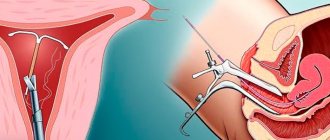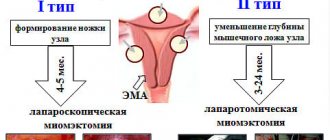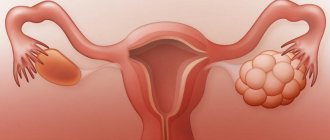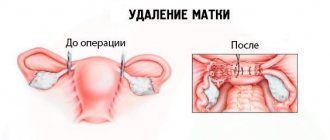In some situations, the intrauterine contraceptive device is removed ahead of schedule in order to prevent pathological complications and side effects.
IUD extraction is performed in the following cases:
- The end of the recommended period of use of the IUD (intrauterine devices can be used for 5-10 years);
- The presence of uncontrolled bleeding from the uterine cavity, which is caused by the insertion of an IUD;
- Pregnancy that occurred while an IUD was installed;
- Change in the growth activity of a benign tumor in the uterine cavity after the introduction of an intrauterine device (fibroids, fibroids);
- Detection of malignant tumor processes of the pelvic organs;
- Expulsion of the IUD - displacement of the intrauterine contraceptive relative to its correct initial position;
- The appearance of an ascending infectious process (gonorrhea);
- The presence of acute inflammatory pathologies of the pelvic organs.
The effect of the IUD on the reproductive system
The intrauterine device is a reliable and popular method of contraception among women who have given birth. Protection against pregnancy is carried out in the following ways:
- Aseptic inflammation in the uterine cavity. The IUD is installed under sterile conditions, the likelihood of infection is minimal. However, even in such cases, aseptic (without pathogenic bacteria) inflammation begins in response to a foreign body in the uterine cavity. As a result, a layer of defective cells forms on the inner surface of the uterus, which prevents the implantation of the fertilized egg if fertilization does occur.
- Effect on sperm. A foreign body in the uterine cavity is a mechanical obstacle to the further advancement of male germ cells.
- The contractility of the uterus increases. The intrauterine device, being in the uterine cavity and irritating its walls, stimulates the activity of the myometrium. This can be expressed in periodic nagging pain in the lower abdomen. In addition, this mechanism prevents the implantation of the fertilized egg into the endometrium.
There are also spirals with metal additives - copper, gold, silver. They have an additional effect and increase the contraceptive effect. In particular, copper-containing IUDs interfere with the activity and motility of sperm, thereby reducing the chances of pregnancy.
In addition, copper ions can influence the peristalsis of the fallopian tubes, which reduces the likelihood of developing an ectopic. Spirals based on silver and gold are more preferable to women who have once suffered from inflammatory processes of the genital organs - endometritis, adnexitis, cervicitis and others.
However, all these are only hypothetical effects of the IUD on a woman’s body. How they prevent pregnancy has not been fully studied. However, even in ancient times, to protect against pregnancy, women placed a spool - a ring of gold - into the uterine cavity immediately after childbirth. Thus, peculiar spirals existed back in Ancient Egypt.
Hormonal IUDs (the most popular and well-known Mirena), in addition to the effect inherent in all IUDs, have a contraceptive effect due to the regular release of gestagens.
And here is more information about dysfunctional uterine bleeding.
Installation of the spiral
Before the doctor inserts an IUD into the uterine cavity, the woman must undergo an examination. The minimum includes the following list:
- medical examination;
- vaginal flora smear;
- smear for oncocytology.
At the discretion of the gynecologist, colposcopy and pelvic ultrasound may be prescribed.
The most favorable time for installing an IUD is days 3-7 of the menstrual cycle, when a woman still has slight spotting. This is due to the following:
- the cervical canal is “slightly open” for the unhindered release of menstrual flow, so it is easier to insert an IUD;
- Pregnancy is definitely ruled out.
Types of intrauterine devices
You should not install an IUD during heavy discharge, as it may not be fixed and may even expel (come out on its own).
Direct insertion of the spiral is a painless procedure and takes 3-5 minutes. At this time, the woman is located on the gynecological chair. The doctor examines the cervix in the speculum, treats it with antiseptics, fixes it with bullet forceps and carefully inserts the IUD (it is small in size - about 2 cm, but in the package it is in a special guide for insertion).
To learn how to install an intrauterine device, watch this video:
What types of spirals exist?
There are two main types of IUDs:
The former contain copper, silver, gold, progesterone, and other hormones or drugs. Their presence in the composition increases the effectiveness of the spiral and reduces the negative impact on the body. These means have different shapes: spirals, rings, etc. The most common contraceptives are:
- Copper-T. It is a device in the shape of the letter T, made of polyethylene with the addition of copper.
- Multiload. It has a T-shape and is made from polyethylene with the addition of barium sulfate.
- Juno. Available in various variations: T-shaped, ring-shaped. The main material is plastic, with additional inclusions including copper or silver. The duration of contraception for ring-shaped forms is 4 years, for T-shaped ones - 7 years.
- Mirena. Intrauterine hormone-containing system. The principle of action is based on the release of gestagen into the uterine cavity. Is a prescription contraceptive.
- Nova-T. The spiral is made of plastic with the addition of barium sulfate, copper and silver wire wound onto an axis.
Is it possible to place it outside of menstruation?
Theoretically, an IUD can be inserted on any day of the cycle. There is even a method of emergency contraception - inserting an IUD within 24 hours after unprotected sexual intercourse. However, in this case, there is a possibility of infection of the uterine lining if the woman was simultaneously infected with an STI during sex.
The disadvantage of inserting an IUD not on critical days is the following:
- pregnancy cannot be ruled out for sure - the fertilized egg may not be visible in the uterine cavity if it has not yet descended, and the test does not always give a reliable result;
- the procedure is more painful - the cervix is often in a spasmodic state on ordinary days.
It is also sometimes practiced to insert an IUD into women immediately after childbirth. However, the doctor must be sure that there are no membranes inside the uterine cavity or inflammation. Otherwise, the procedure risks serious complications. Installation of the IUD is also allowed during breastfeeding if the woman has not yet menstruated. In this case, it is also necessary to first take a blood test for hCG.
Dates for the start of menstruation with a spiral
IUDs, with the exception of hormonal ones, do not affect the onset of the menstrual cycle. And if the IUD is inserted in the last days of menstruation, then the next one, as a rule, arrives on time. However, there are some peculiarities.
First menstruation and its features
Immediately after installation of the IUD, a woman may notice slight spotting or even the re-start of menstruation - thus extending it to 10-14 days. This does not always happen and such features vary from person to person. If the critical days drag on for more than two weeks, you should consult a doctor to prescribe, at a minimum, hemostatic drugs.
The first next menstruation comes as usual in a woman’s cycle - after 21-35 days. They are often more abundant and there may be clots. Many people report pain, even if there was none before.
Second period after installation
Based on the next menstruation, one can already judge how the critical days will pass in the future. They can be ordinary and familiar to a girl. Sometimes periods change so much that they force a woman to have the IUD removed - they become extremely heavy, long-lasting and painful.
How are things going in the third month?
By this time, the body has already fully adapted to the IUD - either accepts it or rejects it. If an IUD brings a lot of inconvenience to a woman, you shouldn’t think that it will go away later—it’s better to use another method of contraception.
All these features are characteristic of classic IUDs. If the system is with hormones (for example, Mirena), the nature and duration of menstruation is completely different, since the body is under the influence of gestagens.
Features of Mirena and menstruation after it
This is a hormone-containing spiral, its analogue is Levonov’s. They are used for contraception, but also have a therapeutic effect. More often prescribed to women over 35 years of age for the prevention and treatment of gynecological pathologies.
Contains Levonorgestrel as an active ingredient. It is also included in such tablets as Postinor, Escapelle, Mirolut. The only difference is in the dose of the substance and the method of entry into the body.
Hormonal IUDs have all the properties of conventional IUDs, plus their action is supplemented by the following points:
- Levonorgestrel has an antiestrogenic and progestogenic effect, which improves the balance of female sex hormones. Therefore, Mirena is prescribed for endometrial polyps, hyperplasia, and recurrent uterine bleeding.
- Levonorgestrel stimulates the thickening of cervical mucus, which makes it difficult for sperm to penetrate into the uterine cavity.
- The active substance leads to endometrial atrophy, so the fertilized egg, even in the event of conception, has “nowhere” to implant.
- The drug does not directly affect ovulation in such a minimal dosage, but has an effect on the secretion of FSH and LH by the pituitary gland.
Considering the action and influence of Mirena and similar IUDs on the body, there are features of the menstrual cycle when using them. Namely:
- menstruation becomes less abundant;
- the duration of critical days decreases;
- the cycle becomes more regular;
- menstruation is less painful.
However, Mirena is not a panacea. Some women are not suitable for this method of treatment and contraception; they experience breakthrough bleeding, pain, and the IUD may come out on its own or become dislodged in the uterine cavity.
Removing the IUD
The average period of use of intrauterine contraception is 5 years. This condition should not be neglected and “forget” about the spiral, which often occurs in women who are not sexually active. Such exceeding of the terms of use threatens various complications - from inflammatory to infertility and cancer.
It is also ideal to remove the IUD in the last days of your period. This way the procedure will be less painful and the possibility of pregnancy will be excluded (rare, but still possible with the use of an IUD). Immediately after removal of the IUD, a woman can become pregnant, so protection should be taken from the first day. The extraction procedure itself takes no more than 5 minutes.
Pregnancy after IUD removal, When is it recommended? and when did it happen?
I tried to find statistics on the Internet and found nothing. I decided to ask here. I had the IUD for about 8 years (3+5) after my first birth. Then, when they decided to get pregnant with their second, I naturally removed it. But I can’t get pregnant, no matter how hard I try. There seems to be no reason for this. So I thought. Is it because the spiral was there before? Girls, when and how soon did you become pregnant after removing the IUD? PS. I looked at the topic How soon did you reach pregnancy. There is no information on this question.
Luna77 passion says it right. The spiral is the most favorable environment for the development of inflammation in the uterus. This is an open door for any kind of infection. Have you been to the gynecologist? To begin with, you need to take smears, and you can be tested for infections. If something is discovered, get treatment and move on. And one more thing. 4 months is not a reason to worry. Even an absolutely healthy woman, who has neither IUDs, nor abortions, nor infections, nor anything else and has never had anything else, can begin to worry only after a year (and according to some reports, 2 years). And you had the IUD for eight years. Now your body needs time to recover and perhaps after some time the long-awaited miracle will appear. Don’t despair and don’t worry, go to a good gynecologist, make sure there is no inflammation and good luck to you
Luna77, I don’t have my own experience with the IUD, but here’s an example: my aunt walked with the IUD for 8 years (after her first birth) and then, as soon as she removed it, she immediately got pregnant. So I think everything is individual. It’s better to go to the doctor, what if there is another reason that interferes with the
Luna77, I don’t have personal experience with the IUD either, but my close friend became pregnant in the first cycle after the IUD was removed. True, she used it less time than you. So, I agree with Carrot - everything is different for everyone
Source
Restoring the cycle after removing the IUD
After removal, the woman’s menstrual cycle gradually returns to the norms that were before its installation. If you have doubts or suspicions of any disease, it is better to consult a doctor.
Heavy periods
If a woman had decent discharge in the uterine cavity during menstruation against the background of an IUD, similar discharge may persist for another couple of months. But if your critical days are accompanied by pain, discharge with clots and an unpleasant odor, you should consult a doctor. Long-term use of an IUD is a risk factor for endometritis. Moreover, while wearing the spiral, a woman could develop fibroids and other pathologies.
Scanty menstruation
They are more common in women who had light periods before the IUD was installed. In addition, pregnancy should be excluded if the discharge is spotting.
Time after IUD removal
In terms of duration, periods also usually become shorter, since the coil itself provokes long-term spotting after the completion of the main discharge.
And here is more information about how to distinguish uterine bleeding from menstruation.
The intrauterine device is a reliable and inexpensive way to prevent pregnancy. But a foreign body in the uterine cavity provokes a change in the nature and duration of menstruation. For some, IUDs are not suitable at all - menstruation becomes so heavy and painful. The doctor’s task is to choose the most suitable IUD option for a woman; the variety of coils produced allows this to be done.
After removal of the IUD
The IUD is removed if the expiration date has expired or if the woman experiences any complications. This procedure is performed by a doctor and is fairly quick, easy and painless. Under no circumstances should you try to remove the intrauterine device yourself. Its extraction must be carried out in a clinical setting by a doctor.
When is the IUD removed?
The IUD is usually removed after three years, but there are IUDs that can be installed for up to 10 years. If, after the introduction of intrauterine contraception, a woman experiences severe pain, then surgical intervention may be necessary; only after removal of the IUD will all undesirable consequences go away.
How is an IUD removed?
It is also recommended to remove the intrauterine device in the presence of severe spotting and bleeding, however, such consequences occur only in 10% of cases during the first year after installation of the IUD. Here, you first need to be examined by a gynecologist and only after the IUD is removed. Bleeding caused by the installation of an intrauterine device can be prolonged and persistent.
It could just be a discharge, it could also be pale skin, as well as a state of general weakness. If all these signs are observed for a long time and/or bother the woman, she should definitely be examined by a specialist.
if there is severe pain immediately or a couple of days after the insertion of the IUD, or during several menstruation;
if partial expulsion of the intrauterine device is observed and if there is no infection or pregnancy, then immediately after removal of the IUD, another device can be installed;
If a woman has an IUD installed and at the same time develops iron deficiency anemia, the doctor prescribes iron supplements.
Source
Useful video
Watch this video about the advantages and disadvantages of the intrauterine device:
For those who have not experienced it, it is difficult to understand what is happening - uterine bleeding or menstruation, how to distinguish them and whether to panic. Indeed, heavy periods are similar to uterine bleeding. However, there are important differences worth knowing.
It can be very difficult to independently understand whether it is heavy periods or bleeding. However, there are clear signs of menstruation and bleeding, as well as additional symptoms for which it is important to see a doctor.
Sometimes long periods become quite common and normal (after an abortion, due to heredity). If they last more than 7 days, with severe pain and red clots, then this is a reason to consult a doctor. It is highly undesirable to carry out treatment on your own.
What are the causes of bleeding after installation or removal of the coil?
If a woman suffers from severe pain and is bleeding after having an IUD inserted, the development of complications should first be ruled out.
Possible causes of bloody discharge immediately after administration:
- IUD rejection;
- incorrectly selected size;
- infectious process;
- endometrial injury during installation.
You can learn about the pros and cons of the intrauterine device by watching this video:
The main cause of bleeding after IUD removal is damage to the uterine mucosa. When the device is removed, microtraumas appear on the endometrium, which can bleed. Usually, unpleasant symptoms disappear after 7–10 days and do not require treatment.
How does the nature of menstruation change after the installation of a non-hormonal IUD?
After the insertion of an intrauterine device, the body takes time to adapt to the contraceptive. We'll look at which ones below.
First menstruation
In most patients, the nature of bleeding changes - it becomes intense and prolonged. This occurs because the IUD irritates the endometrium. Menstruation becomes so heavy that a woman has to use more than 1 pad for 3-4 hours. A nagging pain in the lower abdomen and weakness appear. Sometimes you have to use antispasmodics to relieve discomfort.
In 3 months
During the first month after installation of the IUD, the woman’s body adapts to the foreign body. Menstruation remains abundant and long. There is a nagging pain in the lower abdomen. According to reviews, on average, the duration of menstrual flow increases by 1-2 days. Don't worry: this is a normal reaction of the reproductive system to the introduction of a foreign object into the uterine cavity.
After installing an intrauterine device, spotting and spotting between periods cannot be ruled out. This is also a symptom of the reproductive system adapting to a contraceptive. If they last more than three months and do not disappear, you must definitely visit a gynecologist.
In 6 months
During this period, menstruation returns to its physiological norm. Menstruation may be more abundant, but does not exceed the acceptable limit. In some cases, the pain is stronger than before the contraception was introduced into the uterine cavity.
If the bleeding is very heavy and prolonged, you should consult a gynecologist. The IUD may need to be removed because its side effects outweigh its contraceptive effectiveness. If the IUD is not removed in time, anemia develops.
What to do in case of cycle disorders due to a non-hormonal IUD?
For moderate cycle disorders:
- If spotting between menstruation or light bleeding occurs during the first 6 months after installation of a non-hormonal IUD, treatment is not carried out. This is a completely normal phenomenon and does not pose a danger to a woman.
- If you complain of nagging pain in the lower abdomen during menstruation, anti-inflammatory drugs (ibuprofen, etc.) are prescribed in a short course (3-5 days).
- If there is continuous bleeding, pathology of the pelvic organs should be excluded. An examination by a gynecologist, colposcopy, and ultrasound are indicated. When a disease is detected, its treatment is indicated. The question of removing the coil is decided individually and depends on the diagnosis.
- If there is a significant disruption to normal life due to bleeding, removal of the IUD is indicated.
If there is heavy or prolonged bleeding:
- During the first six months after insertion of the IUD, prolonged or intense bleeding may occur, which does not pose a danger to the woman. No treatment required.
- If the woman’s general condition worsens, anemia develops, or bleeding increases, removal of the IUD is indicated.
Gynecologists point out that the use of copper-containing coils quite often leads to menstrual irregularities in the form of spotting or bleeding. Such symptoms occur in the first 6 months and often become the reason for removing the IUD. Various medications can be used to combat cycle disorders, but their effectiveness is questionable.
Can a violation be a variant of the norm?
Most women bleed after installing the IUD; this is not always a pathology. The contraceptive is administered from the 3rd to the 8th day of the menstrual cycle. During this period, small menstrual flow is still present, and due to mechanical stress, it may intensify. During the process of implantation of a foreign body, small amounts of blood often appear between menstrual cycles.
In case of heavy bleeding, weakness, severe pain, or pale skin, you should immediately consult a doctor.
How does the nature of menstruation change after installing Mirena?
Unlike the non-hormonal intrauterine device, Mirena affects menstruation in a different way:
- Menstruation becomes moderate or scanty, and its volume noticeably decreases.
- The duration of monthly discharge is shortened by 1-2 days.
- Painful sensations in the lower abdomen disappear.
Some patients experience reversible amenorrhea, in which menstruation does not come at all. This is considered normal with Mirena and does not require treatment. If the IUD is removed from the uterus, periods will eventually return. The use of Mirena contributes to the regularity of the cycle and the comfort of menstruation.
Other symptoms after installation of a hormonal IUD:
- Spotting in the middle of the cycle occurs in the first 6 months after the introduction of Mirena and is considered normal. No treatment required.
- If bleeding intensifies or does not stop after six months, you should be examined by a gynecologist. If a pathology is identified, its treatment is indicated.
- If there is severe discomfort due to spotting or bleeding, the Mirena intrauterine system is removed.
To prevent anemia, iron supplements are prescribed and nutrition is adjusted.
Recovery period after IUD removal
For 5-6 days after removal of the IUD, a woman should refrain from intimacy, the use of vaginal tampons and suppositories (suppositories). It is also not recommended to douche, visit the sauna and bathhouse, engage in heavy physical activity and sports, take a hot bath and take medications that contain acetylsalicylic acid. Some women, after removal of the IUD, may experience a pulling, aching pain in the lower abdomen, as well as the appearance of minor bleeding or spotting. The appearance of such pathological conditions is considered normal. They do not require treatment as they should disappear on their own within a few days. The next menstruation may begin with a slight delay, which is also considered normal. If a hormonal IUD was inserted, it may take a little longer for your menstrual cycle to return.
After removal of the intrauterine contraceptive device, pregnancy occurs in 30% of patients within the first month, and in 60% during the first three months. Within 1 year after removal of the IUD, pregnancy occurs in 90-95% of women, provided that at this time they do not use other contraceptives.
The intrauterine device is one of the most popular methods of contraception. Its use allows a woman to live a full sex life. The device causes virtually no complications. In rare cases, a woman notes that she has inserted a coil and is bleeding. The symptom is frightening, but it is worth figuring out whether it is so dangerous, whether it is normal or pathological.
Installation of a uterine device is a popular method of contraception
Dangerous symptoms: when you urgently need to see a doctor
Sometimes a woman notices certain signs that may threaten her health. These include:
- There is no intrauterine device thread in the vagina.
- A spiral is detected in the genital tract, which indicates its loss.
- There was profuse bleeding.
- Intermenstrual discharge occurred six months or more after the insertion of the IUD.
- Menstruation disappeared and did not appear for more than 90 days.
- The appearance of severe or cramping pain in the lower abdomen. Such a symptom may indicate an ectopic pregnancy, ingrowth of the contraceptive into the uterine wall, or perforation of the uterus.
- There was a high temperature, fever with pain in the lower abdomen and vaginal discharge with an unpleasant odor. Such manifestations may be a sign of an inflammatory process.
What complications can there be?
When using intrauterine contraceptives, complications occur extremely rarely. Despite the fact that all consequences are preventable, a woman should know how they manifest themselves and, if necessary, seek medical help:
- Bloody discharge after installation of the IUD is observed in 15% of women. They may appear periodically during the first year of using the contraceptive.
- Expulsion of the IUD. Rejection is manifested by pain in the lower abdomen, bleeding between menstruation, discharge after sexual intercourse, and the sensation of an IUD in the vagina.
- Pregnancy with an IUD. It occurs very rarely and is usually caused by undiagnosed expulsion. In this case, the IUD should be removed as quickly as possible.
- Perforation of the uterus or cervix. The frequency of complications depends on the form of the contraceptive, the anatomical structure of the uterus, and the qualifications of the doctor. It is characterized by severe pain when inserting the coil, disappearance of the threads, and bleeding.
- Infectious processes of the pelvic organs. Complications occur in women who have multiple sexual partners. Symptoms of sexually transmitted infections include discharge with an unpleasant odor, high body temperature, and nausea.
Menstruation after IUD removal
To protect yourself from unwanted effects, removal of the IUD from the uterine cavity should be done exclusively by an experienced gynecologist. Most patients visit the doctor with a complaint about the absence of menstruation after removing a contraceptive. However, practice shows that the disappearance of menstruation depends on the period of use of the contraceptive product, as well as on the degree of thinning of the endometrium. Experts say that if the IUD has been in the uterine cavity for a long time, it will take more time to restore its inner lining.
The nature of the bleeding may change: it becomes profuse and sometimes painful. It will take time for rehabilitation for your periods to return to normal. On average, a woman’s body recovers in 3-6 months.
Some women complain of a delay in menstruation after removal of the IUD. Gynecologists do not consider this phenomenon a pathology. This feature is more typical for those patients who used the Mirena hormonal system. The development of the endometrium and inhibition of ovarian function occur, since the contraceptive injected a small dose of the hormonal substance daily. Usually, after the IUD is removed, all functions return to normal and the cycle is restored.
If the delay in menstruation after removal of the intrauterine device is more than two weeks, it is necessary to exclude pregnancy (take a test or donate blood for hCG).
Lack of menstruation after removal of the IUD
To avoid side effects, only a doctor should remove the intrauterine system. According to statistics, most women turn to a gynecologist with the problem: “I took off the IUD, no period.” However, practice shows that the absence of menstruation depends on the period of use of the IUD and its type, as well as on the thinning of the uterine mucous epithelium. The longer the drug is in the body of the uterus, the more time it takes to restore the endometrial mucosa.
This natural remedy will 100% relieve pain during menstruation! If you guess what it is, you will get rid of it forever!
Often young women, noticing that there are no periods after removing the IUD, worry about the high likelihood of pregnancy. However, these suspicions turn out to be unfounded. The cause of the delay (up to 6 months) may be a hormonal disorder, as well as ovarian dysfunction. These features occur if other causes are excluded (inflammatory diseases of the pelvic area, genital tract infections or pregnancy). To do this, you should visit a gynecologist.
Late menstruation after removal of the IUD
Another feature observed in patients who have had an intrauterine contraceptive device removed is delayed menstruation. This feature appears in women who have used the latest generation of Mirena. Most often, the delay after removal of the IUD is associated with suppression of endometrial development, as well as inhibition of ovarian function. After all, a small dose of the hormone is injected daily with a contraceptive into the uterine cavity. As a rule, after removing the medication, all functions are restored.
Gynecologists around the world agree that a delay in menstruation after removal of the IUD is quite normal. This is also due to a decrease in the reproductive function of the female body due to the action of the contraceptive. After its removal, reproductive function gradually returns to normal, and, consequently, the menstrual cycle normalizes.
Heavy periods after removal of the IUD – menorrhagia
The way your period progresses after the IUD is an indicator of the effect of the IUD on the body. After all, choosing the wrong size entails various side effects: inflammatory processes, infectious diseases, thinning of the uterine mucosa, ectopic pregnancy.
Very often, women experience heavy periods after installing the IUD. They can appear due to the above factors, and also become a consequence of hormonal imbalance that occurs when wearing a contraceptive for a long time. Heavy menstruation causes large blood losses, which reduces hemoglobin and worsens the well-being of women, since anemia, general weakness, and dizziness may develop.
After removal of the IUD, each woman’s period appears at different times. This is due to the characteristics of the body and the factors described above.
This remedy relieved all Chinese women from menstrual pain! It will help you too! You stick it on the groin and forget about the pain!
Menstruation after installation of the IUD
The process of inserting an intrauterine contraceptive and subsequent adaptation is stressful for the body. The nervous system suffers, hormonal levels become unstable. The consequences of the changes taking place are very different. Most often, periods with a spiral occur on schedule, in some cases failures are possible. The woman may feel pain and severe weakness. Some experience an increase in discharge.
Intensity and abundance are usually associated with the irritating effect of the spiral on the uterine mucosa. In addition, suppression of the endometrium becomes one of the reasons for delayed periods. Late menstruation can be caused by other factors.
Reasons for the delay of critical days
A delay in menstruation after installation of the IUD is not a pathology. The regularity of the cycle will be restored over time. Much will depend on the quality and composition of the installed product.
Normalization of the cycle with the hormonal intrauterine system is faster. Delays in menstruation are more common with metal-containing products. When a failure is accompanied by severe pain, the contraceptive is removed ahead of time.
If you haven't had your period for more than two weeks, take a pregnancy test. If there is no discharge for a long time, conception should not be ruled out. The spirals move from their place, descend into the cervical canal and simply fall out. This is unlikely, but this happens due to the poor quality of the product, improper installation or the individual characteristics of the female body.
Full physiological recovery after installation of an intrauterine contraceptive occurs after 3 months. If during this time the cycle has not returned to normal, and delays in a negative pregnancy test are accompanied by painful symptoms, contact a gynecologist.
Causes of heavy and prolonged menstruation
The first periods after installation of the IUD are scanty. An increase in discharge is observed from the second month, heavy menstruation should end by the end of the third, when the hormonal levels stabilize. If the course of your cycle follows a different scenario, your periods take a long time, and their volume does not decrease, visit a gynecologist. There is a possibility of complications developing. The most common include:
- damage to the uterus;
- displacement of the contraceptive into the abdominal cavity;
- anemia;
- bloody and purulent discharge;
- risk of developing inflammatory processes.
When agreeing to use an intrauterine device, a woman should know how many days her period lasts while wearing the IUD, what is its intensity and how the condition changes with possible complications. Spotting and cramping pain in the abdominal area indicate incorrect positioning or displacement of the contraceptive product.
Prolonged periods, accompanied by an increase in body temperature, indicate the onset of inflammation in the reproductive system. Excessive brown blood loss with increasing pain is a common sign of intrauterine pregnancy.
It is important to understand that all problems of the reproductive system do not go away on their own, and without the participation of a doctor it is impossible to identify the cause of atypical behavior of menstruation after the IUD.
There are several reasons for heavy menstruation. A separate article on our website will tell you more about them.
Menstruation after removal of the IUD
The course of menstruation after removing a contraceptive is an indicator of the impact of the IUD on the female body. Much depends on how long the product spent in the uterus. The longer it was in the cavity, the longer it will take for the endometrium to recover.
It will take from 2 weeks to several months to normalize the cycle and complete rehabilitation of the body. This depends on the period of use of the intrauterine system, the age and health of the woman, the degree of thinning of the uterine lining and other factors.
Irregularity of menstruation after removal of the IUD is often associated with complications. Infectious and inflammatory diseases are considered the most dangerous. Any abnormalities, including hormonal disorders, affect not only the regularity of discharge. The nature and duration of menstruation may change. This leads to large blood losses and deterioration of health.
Restoring the cycle after removing the spiral
After removal of the IUD, most women do not lose their periods. Common changes: a reduction in their number, which can be explained simply - the impact of the foreign body on the uterine cavity stops, and bleeding becomes weaker.
If the IUD was removed during menstruation, their next arrival is possible exactly on schedule. However, a shift in menstruation in time, or slight delays, may also be possible. The risk increases if you remove the device without having your period. The reason may be insufficient growth of the endometrium and difficulties with its rejection.
After removal of the hormonal intrauterine device, there is likely to be a slight fluctuation in hormonal levels, due to which there may also be a delay in the next menstruation. If the cycle has gone wrong before, this reaction of the body almost always occurs.
You should consult a doctor in case of a positive test result, absence of menstruation for more than 2 months, severe pain during menstruation, purulent or green clots in the discharge, and other disorders.
How to prevent and eliminate adverse reactions
The development of complications when using non-hormonal IUDs is observed much more often. Hormonal ones are more reliable and safe, but in any case, when choosing the type and shape of the product, you must take into account the doctor’s recommendations.
In most cases, difficulties and undesirable reactions with the IUD arise due to the installation of low-quality IUDs and underestimation of contraindications. Among them are sexually transmitted diseases, erosion of the uterine cervix, infections and inflammations of the genital tract, and tumor neoplasms. When pathology is detected after installation of an intrauterine contraceptive device, the IUD can be removed.
The experience of the specialist who will do the installation is very important. Errors during this medical procedure lead to numerous side effects.
Wearing time is of great importance. The foreign body is removed after the expiration date. If this is not done, health problems may occur.
After installing or removing the coil, no specific care is required. It is enough to follow traditional hygiene rules, regularly see a gynecologist and do what the doctor recommends.
“>










